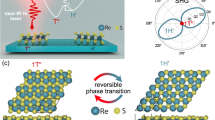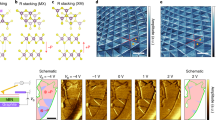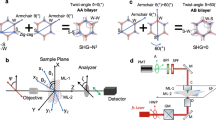Abstract
Crystal phase plays a crucial role in determining the properties of two-dimensional (2D) transition metal dichalcogenides. Here we achieve phase-switchable preparation of 2D transition metal dichalcogenides using an electrochemical lithium-ion intercalation-based exfoliation strategy by controlling the discharge current density and cutoff voltage. We discover that a small discharge current density (0.005 A g−1, with a 0.9 V cutoff voltage) produces pure semiconducting 2H phase WS2 bilayers. In contrast, a large discharge current density (0.02 A g−1, with a 0.7 V cutoff voltage) leads to the dominant semimetallic 1T′ phase WS2 monolayers. The phase-switching mechanism was clarified through cryo-electron microscopy, annular dark-field scanning transmission electron microscopy, Raman, X-ray photoelectron spectroscopy, etc. The device (humidity sensor) application of produced 2D WS2 was then demonstrated, showing phase-dependent humidity-sensing performances confirming the potential of our produced 2D WS2 with switchable phase in device applications.

This is a preview of subscription content, access via your institution
Access options
Subscribe to this journal
Receive 12 digital issues and online access to articles
118,99 € per year
only 9,92 € per issue
Buy this article
- Purchase on SpringerLink
- Instant access to full article PDF
Prices may be subject to local taxes which are calculated during checkout




Similar content being viewed by others
Data availability
The data that support the findings of this study are available within the article and its Supplementary Information. Source data are provided with this paper.
References
Yang, R. J. et al. Intercalation in 2D materials and in situ studies. Nat. Rev. Chem. 8, 410–432 (2024).
Mei, L. et al. Metallic 1T/1T' phase TMD nanosheets with enhanced chemisorption sites for ultrahigh-efficiency lead removal. Nat. Commun. 15, 7770 (2024).
Chhowalla, M. et al. The chemistry of two-dimensional layered transition metal dichalcogenide nanosheets. Nat. Chem. 5, 263–275 (2013).
Li, Z. N. et al. Lithiated metallic molybdenum disulfide nanosheets for high-performance lithium-sulfur batteries. Nat. Energy 8, 84–93 (2023).
Chen, W. S. et al. Two-dimensional quantum-sheet films with sub-1.2 nm channels for ultrahigh-rate electrochemical capacitance. Nat. Nanotechnol. 17, 153–158 (2022).
Acerce, M. et al. Metallic 1T phase MoS2 nanosheets as supercapacitor electrode materials. Nat. Nanotechnol. 10, 313–318 (2015).
Yu, Y. F. et al. High phase-purity 1T′-MoS2- and 1T′-MoSe2-layered crystals. Nat. Chem. 10, 638–643 (2018).
Voiry, D. et al. Conducting MoS2 nanosheets as catalysts for hydrogen evolution reaction. Nano Lett. 13, 6222–6227 (2013).
Voiry, D. et al. Enhanced catalytic activity in strained chemically exfoliated WS2 nanosheets for hydrogen evolution. Nat. Mater. 12, 850–855 (2013).
Shi, Z. Y. et al. Phase-dependent growth of Pt on MoS2 for highly efficient H2 evolution. Nature 621, 300–305 (2023).
Lai, Z. C. et al. Metastable 1T′-phase group VIB transition metal dichalcogenide crystals. Nat. Mater. 20, 1113–1120 (2021).
Yang, R. J. et al. 2D transition metal dichalcogenides for photocatalysis. Angew. Chem. Int. Ed. 62, e202218016 (2023).
Wang, Q. H. et al. Electronics and optoelectronics of two-dimensional transition metal dichalcogenides. Nat. Nanotechnol. 7, 699–712 (2012).
Sebastian, A. et al. Benchmarking monolayer MoS2 and WS2 field-effect transistors. Nat. Commun. 12, 693 (2021).
Radisavljevic, B. et al. Single-layer MoS2 transistors. Nat. Nanotechnol. 6, 147–150 (2011).
Yang, R. et al. Synthesis of atomically thin sheets by the intercalation-based exfoliation of layered materials. Nat. Synth. 2, 101–118 (2023).
Pinilla, S. et al. Two-dimensional material inks. Nat. Rev. Mater. 7, 717–735 (2022).
Coleman, J. N. et al. Two-dimensional nanosheets produced by liquid exfoliation of layered materials. Science 331, 568–571 (2011).
Lin, Z. Y. et al. Solution-processable 2D semiconductors for high-performance large-area electronics. Nature 562, 254–258 (2018).
Li, J. et al. Printable two-dimensional superconducting monolayers. Nat. Mater. 20, 181–187 (2021).
Liu, N. et al. Large-area atomically thin MoS2 nanosheets prepared using electrochemical exfoliation. ACS Nano 8, 6902–6910 (2014).
Jeong, S. et al. Tandem intercalation strategy for single-layer nanosheets as an effective alternative to conventional exfoliation processes. Nat. Commun. 6, 5763 (2015).
Eda, G. et al. Photoluminescence from chemically exfoliated MoS2. Nano Lett. 11, 5111–5116 (2011).
Yang, R. J. et al. High-yield production of mono- or few-layer transition metal dichalcogenide nanosheets by an electrochemical lithium ion intercalation-based exfoliation method. Nat. Protoc. 17, 358–377 (2022).
Li, W. et al. Phase transitions in 2D materials. Nat. Rev. Mater. 6, 829–846 (2021).
Song, X. Y. et al. Synthesis of an aqueous, air-stable, superconducting 1T′-WS2 monolayer ink. Sci. Adv. 9, eadd616 (2023).
Chou, S. S. et al. Understanding catalysis in a multiphasic two-dimensional transition metal dichalcogenide. Nat. Commun. 6, 8311 (2015).
Wang, X. F. et al. Cryogenic electron microscopy for characterizing and diagnosing batteries. Joule 2, 2225–2234 (2018).
Fan, X. B. et al. Controlled exfoliation of MoS2 crystals into trilayer nanosheets. J. Am. Chem. Soc. 138, 5143–5149 (2016).
Guo, P. et al. An all‐printed, fast‐response flexible humidity sensor based on Hexagonal‐WO3 nanowires for multifunctional applications. Adv. Mater. 35, 2304420 (2023).
Anichini, C. et al. Chemical sensing with 2D materials. Chem. Soc. Rev. 47, 4860–4908 (2018).
He, H. N. et al. Anion vacancies regulating endows MoSSe with fast and stable potassium ion storage. ACS Nano 13, 11843–11852 (2019).
Lopez-Sanchez, O. et al. Ultrasensitive photodetectors based on monolayer MoS2. Nat. Nanotechnol. 8, 497–501 (2013).
Akinwande, D. et al. Two-dimensional flexible nanoelectronics. Nat. Commun. 5, 5678 (2014).
Chang, H. Y. et al. High-performance, highly bendable MoS2 transistors with high-K dielectrics for flexible low-power systems. ACS Nano 7, 5446–5452 (2013).
Li, S. et al. Humidity-sensitive chemoelectric flexible sensors based on metal-air redox reaction for health management. Nat. Commun. 13, 5416 (2022).
Feng, J. et al. Giant moisture responsiveness of VS2 ultrathin nanosheets for novel touchless positioning interface. Adv. Mater. 24, 1969–1974 (2012).
Zhao, J. et al. Highly sensitive MoS2 humidity sensors array for noncontact sensation. Adv. Mater. 29, 1702076 (2017).
Yu, X. G. et al. Skin-integrated wireless haptic interfaces for virtual and augmented reality. Nature 575, 473–479 (2019).
Kresse, G. et al. Ab-Initio molecular-dynamics for open-shell transition-metals. Phys. Rev. B 48, 13115–13118 (1993).
Perdew, J. P. et al. Generalized gradient approximation made simple. Phys. Rev. Lett. 77, 3865–3868 (1996).
Grimme, S. et al. Effect of the damping function in dispersion corrected density functional theory. J. Comput. Chem. 32, 1456–1465 (2011).
Acknowledgements
Z.Zeng thanks the Young Collaborative Research Grant (project no. C1003-23Y) and General Research Fund (GRF) (project no. CityU11308923) support from the Research Grants Council of the Hong Kong Special Administrative Region, China, the Basic Research Project from Shenzhen Science and Technology Innovation Committee in Shenzhen, China (project no. JCYJ20210324134012034), and the Applied Research Grant of City University of Hong Kong (project no. 9667247) and Chow Sang Sang Group Research Fund of City University of Hong Kong (project no. 9229123). Z.Zeng also thanks the funding supported by the Seed Collaborative Research Fund Scheme of State Key Laboratory of Marine Pollution, which receives regular research funding from Innovation and Technology Commission (ITC) of the Hong Kong SAR Government. However, any opinions, findings, conclusions or recommendations expressed in this publication do not reflect the views of the Hong Kong SAR Government or the ITC. X.Y. thanks the support from Research Grants Council of the Hong Kong Special Administrative Region (grant no. RFS2324-1S03) and Shenzhen Science and Technology Innovation Commission (grant no. SGDX20220530111401011). M.G. acknowledges the support from Guangdong Fundamental Research Association (project no. 2022B1515120013), National Natural Science Foundation of China (project no. 52273225) and Guangdong scientific programme (contract no. 2019QN01L057). L.G. thanks the funding support from National Natural Science Foundation of China (project nos. 52250402, 51991344 and 52025025).
Author information
Authors and Affiliations
Contributions
Z. Zeng conceived and guided the project. L.M. designed and performed the synthesis and characterizations of all the materials. Z.G. and X.G.Y. performed the device fabrication and performance test. D.L., T.Y., H.H., J.Z., D.V. and Y.C. helped to analyse the results. Z. Zhang and M.D.G. carried out the cryo-electron microscopy test. M.S., X.L., Y.Z., B.H. and X.C.Z. conducted the DFT calculations. Q.Z. and L.G. performed the HAADF-STEM test of the samples. L.M., Z.G., R.Y., J.L., X.Y. and Z. Zeng drafted the paper. All authors checked the paper and agreed with its content.
Corresponding authors
Ethics declarations
Competing interests
The authors declare no conflicts of interest.
Peer review
Peer review information
Nature Synthesis thanks Qiaoliang Bao and the other, anonymous, reviewer(s) for their contribution to the peer review of this work. Primary Handling Editor: Alexandra Groves, in collaboration with the Nature Synthesis team.
Additional information
Publisher’s note Springer Nature remains neutral with regard to jurisdictional claims in published maps and institutional affiliations.
Supplementary information
Supplementary Information
Supplementary Figs. 1–47 and Tables 1 and 2.
Source data
Source Data Fig. 1
Unprocessed characterization data for 2H and 1T′-WS2.
Source Data Fig. 3
Unprocessed humidity sensor performance data for 2H and 1T′-WS2.
Source Data Fig. 4
Unprocessed humidity sensor array performance data for 2H-WS2.
Rights and permissions
Springer Nature or its licensor (e.g. a society or other partner) holds exclusive rights to this article under a publishing agreement with the author(s) or other rightsholder(s); author self-archiving of the accepted manuscript version of this article is solely governed by the terms of such publishing agreement and applicable law.
About this article
Cite this article
Mei, L., Gao, Z., Yang, R. et al. Phase-switchable preparation of solution-processable WS2 mono- or bilayers. Nat. Synth 4, 303–313 (2025). https://doi.org/10.1038/s44160-024-00679-2
Received:
Accepted:
Published:
Issue Date:
DOI: https://doi.org/10.1038/s44160-024-00679-2
This article is cited by
-
Programmable phase switching and exfoliation
Nature Synthesis (2024)



